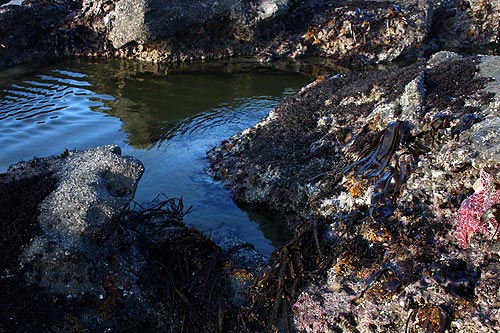Video: Oregon Coast Talking Barnacles - Rare Sound Recording
Updated Periodically
By Oregon Coast Beach Connection Staff

(Cannon Beach, Oregon) – UPDATED: WHERE TO FIND TALKING BARNACLES - Strangely, there’s almost nothing written about this little marine science curiosity. Did you know barnacles make noises? It's a weird bit of Oregon coast fun, and finally someone caught video of it. (A full list of Oregon coast tidepools is here - where you may encounter these barnacles)
It began with a challenge from Oregon Coast Beach Connection's editor.
“This summer I issued a challenge to the Haystack Rock Awareness Program in Cannon Beach: ‘since you’re around tidepools all the time, see if you can record the sounds that barnacles make,” said editor Andre' Hagestedt.
The group accepted and did just that. This curious clicking or chattering noise is rarely documented, and seems to go unnoticed by many.
Barnacles – in this case, acorn barnacles – do this periodically on the Oregon coast. If several of them do it at the same time, it sounds like they’re talking to each other. It’s a surreal experience to suddenly hear that noise when you’re poking around a tidepool.
In the video, you can even see one of them moving briefly, which is startlingly awesome.
Includes exclusive listings; some specials in winter
In Cannon Beach:
Includes rentals not listed anywhere else
In Manzanita, Wheeler, Rockaway Beach:
Some specials for winter
In Pacific City, Oceanside:
Some specials for winter
In Lincoln City:
Some specials for winter
In Depoe Bay, Gleneden Beach:
Some specials for winter
In Newport:
Look for some specials
In Waldport
Some specials for winter
In Yachats, Florence
Some specials for winter
Acorn barnacles live inside two shells. When they’re disturbed by something, they move around in there, essentially “clamming up” (if you’ll excuse the pun). That causes the clacking noise. It doesn’t take much to jolt them: simply a shadow coming across them or another presence will cause them to shift.
In effect, it’s probably you that has caused them to move around, just by being there or having your shadow move over them.
Keith Chandler, manager of Seaside Aquarium, explained more.
“It happens when they twist around inside their shells,” Chandler said. “When something disturbs them. If something pokes your eye, you're going to move your head around.”
The acorn barnacle's scientific name is Balanus glandula, and they're extremely common to the Oregon coast and indeed the entire U.S. and Canadian shorelines. They are crustaceans, which makes them more closely related to the crab and / or lobsters.
Inside these two shells sits a tiny arthropod, which means it’s an invertebrate animal that has an exoskeleton, a segmented body, and paired jointed appendages. The other really trippy thing about them: according to Chandler, they live inside those shells at an odd angle where the forehead of the creature is actually stuck to the inside of the shell.
The bottom part is a feathery pair of legs, which stick out and are used to grab food.
“They feed on plankton when the tide is high,” Chandler said. “When the tide is low, they close up. They stick their little fan thingy out to grab the plankton. They're really fun to watch.”
Those legs actually bring in the oxygen to the creature as well, acting like gills, in a sense.
In order to hear this trippy little sound, you have to find them in a certain state. Chandler said they have to be partially submerged in water. If they’re in the open air they’re closed up. If they’re underwater, you of course can’t hear them.
The Seaside Aquarium usually has these on display, although you can’t hear the sounds because they’re in a tank. Oregon Coast Lodgings for this event - Where to eat - Maps - Virtual Tours
Cannon Beach Lodging
Nehalem Bay Lodgings
Manzanita Hotels, Lodging
Three Capes Lodging
Pacific City Hotels, Lodging
Lincoln City Lodging
Depoe Bay Lodging
Newport Lodging
Waldport Lodging
Yachats Lodging
Oregon Coast Vacation Rentals
Oregon Coast Lodging Specials



More About Oregon Coast hotels, lodging.....
More About Oregon Coast Restaurants, Dining.....
LATEST Related Oregon Coast Articles
Likely just before dawn best hour but peak happens during daylight. Weather
Dark Sky Week is Prime Along Oregon Coast: Where and Where Not to Go
General guide to dark sky viewing from south to north coast. Astronomy
Sizable Price Drop, Deals in Lincoln City During Quiet of April on Central Or...
20 perc off at A1 Vacation Rentals across its roster, including Gleneden Beach. Lincoln City specials
Upcoming S. Oregon Coast Events Include Gem Show, History: Coos Bay, Bandon
May 6 talk at Coos History Museum, Mayfly Fest May 17, Bandon Rock / Gem Show June 7,8
Washington Coast Cleanup on April 19 - Coinciding with Oregon Coast's SOLVE E...
From the Puget Sound to Long Beach, alongside Oregon's cleanup. Washington coast events, Seaside events
Astoria's Riverwalk Gets New Lighting, More N. Oregon Coast Roadwork
Delays coming this summer, but the riverwalk has a new look. Seaside, Cannn Beach
April Gets Even Cheaper Midweek at Depoe Bay, Lincoln City: Oregon Coast Deals
Off-season rates plus more at Keystone Vacation Rentals. Depoe Bay lodging specials, Lincoln City hotel reviews, Newport hotel reviews
Washington Coast Begins Week of Clam Digs, April 12 Through 18
Long Beach, Twin Harbors, Mocrocks and Copalis at different times. Washington coast events
Back to Oregon Coast
Contact Advertise on BeachConnection.net
All Content, unless otherwise attributed, copyright BeachConnection.net Unauthorized use or publication is not permitted




















































